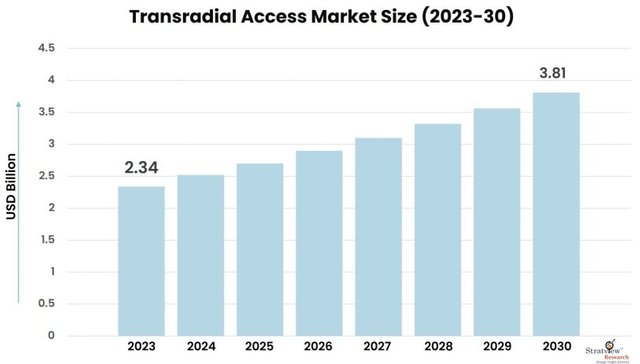Understanding the Impact of Evolving Healthcare Needs on the Transradial Access Market
The global transradial access market is witnessing remarkable growth, driven by the evolving needs of modern healthcare systems. Transradial access, a technique primarily used in cardiovascular interventions and diagnostic procedures, has gained significant traction due to its minimally invasive nature, improved patient outcomes, and lower complication rates compared to traditional femoral access methods.
According to Stratview Research, the transradial access market was estimated at USD 2.34 billion in 2023 and is likely to grow at a CAGR of 7.17% during 2024-2030 to reach USD 3.81 billion in 2030.
Growing Demand for Minimally Invasive Procedures
The shift towards minimally invasive medical procedures is a key driver for the transradial access market. Patients and healthcare providers increasingly prefer procedures that offer shorter recovery times, reduced hospital stays, and lower risks of complications. This trend has bolstered the adoption of transradial access in angiography, percutaneous coronary interventions (PCI), and other vascular procedures.
Rising Prevalence of Cardiovascular Diseases
The growing prevalence of cardiovascular diseases (CVDs) globally is another significant factor influencing the market. According to the World Health Organization (WHO), CVDs are the leading cause of death worldwide, necessitating innovative and effective treatment solutions. Transradial access provides a safer and more efficient alternative for managing these conditions, further driving its demand.
Technological Advancements and Product Innovation
Advancements in catheter technology and the development of specialized transradial access kits have made the technique more accessible and reliable. Improved device ergonomics, enhanced guidewire technology, and radial-specific hemostasis devices have reduced procedural complexities and improved patient safety, contributing to market growth.
Expanding Applications and Awareness
While traditionally associated with coronary procedures, the applications of transradial access are expanding to include peripheral vascular interventions and oncological treatments. Growing awareness among clinicians about the benefits of transradial access, such as reduced bleeding risks and enhanced patient comfort, has further accelerated its adoption.
Challenges and Future Outlook
Despite its advantages, the transradial access market faces challenges, such as the steep learning curve for practitioners and the need for specialized training. Additionally, regional disparities in adoption rates, particularly in emerging economies, highlight the need for broader education and infrastructure development.
Looking ahead, the market is poised for continued growth as healthcare systems emphasize patient-centric care and cost-efficiency. Investments in research and development, coupled with rising healthcare expenditures, are expected to unlock new opportunities for transradial access technologies.
In conclusion, evolving healthcare needs, driven by the demand for minimally invasive solutions, the burden of CVDs, and technological innovations, are shaping the future of the transradial access market. As this trend continues, the technique is set to play an integral role in advancing cardiovascular care and beyond.
